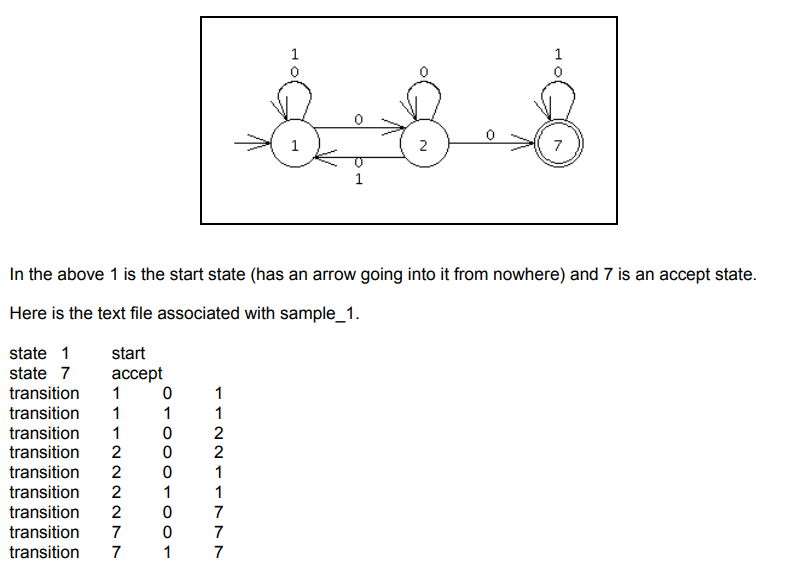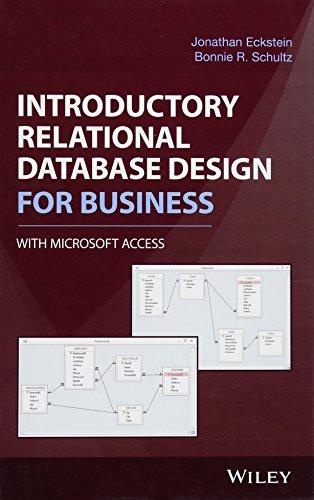Question
Write a program in C++ to simulate the execution of a partial non deterministic finite automata (partial since we don't have epsilon transitions). Your program
Write a program in C++ to simulate the execution of a partial non deterministic finite automata (partial since we don't have epsilon transitions). Your program will read the definition of the machine from a file (the first command line argument), with the second command line argument being the string to simulate the machine running on (the input to the automata). The output of your program will be written to standard output. The output will consist of either: 1) the word accept followed by a blank space followed by the list of accept states (blank space delimited) that the automata can end up in after reading in the input string (if there is a way for the automata to end in an accept state after reading the input); or 2) the word reject followed by a blank space followed by the list of states (blank space delimited) that the automata can end up in after reading the string (if there is no way for the automata to end in an accept state after reading the input). Your output needs to end with the newline character. The input file will be tab delimited (should be easily parsed by C++). For this program, the states will be numbered between 0 and 1,000 (not necessarily contiguous or entered in order). There are two types of special states the start state (only one) and the accept states (0 or more).
There are two types of input lines: state lines and transition lines. The state lines are of the form:
state x start
state x accept
state x acceptstart
state x start accept
where x is a number in [0, 1000]. States that are neither accept or start states will not have an input line. Note in the above, there is a tab between accept and start in statex acceptstart. You should not assume that the start state is state 0.
Here are some examples:
state 7 start accept
state 10 acceptstart
state 20 accept
state 27 start
There is no guarantee that the first state is the start state or that the states are in order or they are contiguous. The remainder of the file defines the transitions. For this machine, the transition format is p,x->q where p is the current state that the machine is in, x is the symbol that the machine reads, and q is the state that the machine transitions to. There will be at most 100,000 transitions. The format of the transitions in the file will be: transition p x q where p and q are states in [0, 1000], and x is the symbol to read. For this program you can assume that x will be a digit {0, 1, , 9} or a lower case letter {a, b, , z}.
Since the machine is non deterministic, there may be multiple states that the automata can transition to for a single state and input symbol combination. The input will be a string, consisting of digits and lower case letters. Initially the machine will be looking at the left most symbol of the input string and in the start state (just like the finite automata that we are currently discussing in class). If the machine can end in an accept state after reading the input string, then your program should output accept followed by a blank space followed by the list of accept states that the automata can end in after reading the entire input. The states can be output in any order, but each state is to be only listed once. If the machine can never end in an accept state after reading the input string, then your program should output reject followed by a blank space followed by the list of all states that the automata can end in after reading the input. The states can be output in any order, but each state is to be only listed once. If there is no transition for the given state and input symbol, then you should assume that the current branch of the computation ends in a non accept state (although, you will not have a state for this branch to add to the list of states reached after reading the input). For C++, standard input is cin, standard output is cout, and standard error is cerr.  Below are some sample runs that ideally are correct.
Below are some sample runs that ideally are correct.
./p1 sample_1.txt 0
reject 1 2
./p1 sample_1.txt 000
accept 7
In the above 1 is the start state (has an arrow going into it from nowhere) and 7 is an accept state. Here is the text file associated with sample_1Step by Step Solution
There are 3 Steps involved in it
Step: 1

Get Instant Access to Expert-Tailored Solutions
See step-by-step solutions with expert insights and AI powered tools for academic success
Step: 2

Step: 3

Ace Your Homework with AI
Get the answers you need in no time with our AI-driven, step-by-step assistance
Get Started


